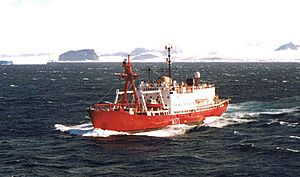HMS Endurance (1967) facts for kids
 |
|
Quick facts for kids History |
|
|---|---|
| Name | Anita Dan |
| Owner | Lauritzen Lines |
| Builder | Kröger-Werft, Schacht-Audorf |
| Yard number | 1080 |
| Laid down | 26 May 1956 |
| Launched | 26 May 1956 |
| In service | October 1956 |
| Fate | Sold to the Royal Navy, 1967 |
| Name | Endurance |
| Acquired | 1967 |
| Out of service | 1991 |
| Homeport | Chatham and Portsmouth |
| Identification | IMO number: 5017967 |
| Nickname(s) |
|
| Fate | Scrapped |
| General characteristics | |
| Type | Icebreaker |
| Displacement | 3,600 long tons (3,658 t) |
| Length | 93 m (305 ft) |
| Beam | 14 m (46 ft) |
| Draught | 5.5 m (18 ft) |
| Propulsion | 1 × Burmeister & Wain diesel engine |
| Speed | 14.5 knots (26.9 km/h; 16.7 mph) |
| Complement | 119 |
| Armament | 2 × Oerlikon 20 mm cannon |
| Aircraft carried |
|
| Service record | |
| Operations: | Falklands War |
HMS Endurance was a special ship in the Royal Navy. She was an icebreaker and patrol vessel. She served from 1967 to 1991.
Endurance became famous during the Falklands War in 1982. The war's final surrender happened on board Endurance in the South Sandwich Islands.
Contents
About HMS Endurance
Endurance was first built in Germany in 1956. Her original name was Anita Dan. She was a ship for a Danish company called Lauritzen Lines.
In 1967, the UK government bought the ship. She was then changed to become a Royal Navy vessel. They renamed her HMS Endurance. This name honored another ship called Endurance. That ship carried the explorer Ernest Shackleton to Antarctica in 1914.
What Endurance Did
Early Years (1967–1982)
The new Endurance helped the UK stay present in Antarctica and the Falkland Islands. She worked there during the southern summer months. She also supported the British Antarctic Survey, which studies Antarctica.
Endurance had a bright red hull. This color is common for ships that work in icy places. It helps them be seen easily. But it was unusual for a Royal Navy ship. Because of this, her crew called her The Red Plum.
In February 1972, Endurance helped rescue people. The cruise ship Lindblad Explorer got stuck. Endurance was nearby and helped save everyone.
The ship also had special equipment to listen to radio signals. This helped gather information from South America. Her captain even said that this listening equipment was like the ship's main weapon.
In 1981, the government planned to stop using Endurance. She was set to be taken out of service in April 1982.
The Falklands War
Many people in Britain thought that taking Endurance out of service was a mistake. They believed it made Argentina think the UK was not serious about defending the Falkland Islands. A report later said this might have made Argentina doubt Britain's commitment.
On March 19, 1982, Endurance was at Stanley. News arrived that Argentine people had landed on South Georgia. They raised the Argentine flag. These people were actually Argentine Marines pretending to be scrap-metal workers.
Endurance, led by Captain Nick Barker, was sent to tell the Argentines to leave. She carried a small group of Royal Marines. Endurance sailed for South Georgia on March 21.
When Endurance arrived on March 25, she found another Argentine ship. This ship had brought 40 Argentine troops ashore. Endurance landed her marines. Then she returned to the Falklands on March 30. In April, Endurance was ordered to join the main UK Task Force.
Endurance was part of a battle on April 25, 1982. Her two Wasp helicopters helped attack an Argentine submarine. The submarine, called ARA Santa Fe, was later left by its crew. When Argentine forces gave up the next day, Endurance stayed nearby. She showed the British flag and guarded the waters.
Endurance also rescued two wildlife filmmakers. Cindy Buxton and Annie Price were working on South Georgia when the war started.
After Argentina surrendered the Falkland Islands, Endurance sailed to the South Sandwich Islands. Argentina had a base there since 1976. Endurance was carrying a Wessex helicopter for the first time. She also had her two Wasps.
Ten Argentine soldiers surrendered after seeing a firing display from another British ship. They also saw that British marines had landed. The surrender was officially signed on board Endurance.
Later Years (1983–1991)
Towards the end of her service, the ship had many problems. Because of this, some people nicknamed her HMS Encumbrance.
In 1989, Endurance hit an iceberg. She was repaired, but a check in 1991 showed her hull was not strong enough. She could not safely return to Antarctica. So, she was finally taken out of service. A new ship, later named HMS Endurance, replaced her.
See also
- Endurance Reef


